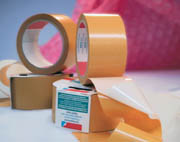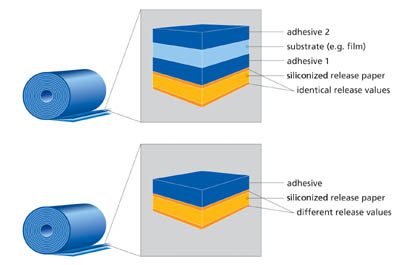
Everyday carpet tape is by no means where the application range of adhesive tapes ends. Rather, it is multifaceted in use, being employed to affix everything from the entire interior trim of cars to parts of mobile telephones.
The prerequisites for such universal industrial use are higher production speeds and greater operational efficiency. This has led to increased use of automatic dispensers for self-adhesive products, a trend that naturally places even greater demands on the required materials, in particular on the double-sided siliconized release paper bearing the adhesive.
Adhesive tapes currently available on the market are produced in one of two ways: the classic method or the transfer method.

The Classic Method
Adhesive tape produced using the classic method consists of several layers (see figure), namely double-sided silicone-coated paper, a pressure-sensitive adhesive layer, substrate material and another adhesive layer. The substrate material (fabricor film, for example) provides for the durability of the tape. By varying the type, amount or combination of substrate material and adhesive used, it is possible to produce products custom-made to a range of applications.One crucial consideration in the production of adhesive tapes is ensuring that the release value of the double-sided siliconized paper is suited to the adhesive being used. The release value refers to the force, measured in cN, which is needed to separate the release paper from the adhesive.
Dispensing and working with classic adhesive tape is generally hassle-free due to the fact that the substrate material embedded in the adhesive provides the adhesive tape with the requisite inner stability.
This prevents a process known as "confusion," i.e., when winding occurs from the front to the reverse side of the release paper, even if both sides have the same or slightly different release values. In other words, confusion is a process in which the adhesive film alternately adheres with greater force to one side than the other, thus making it impossible to create a proper roll.
Transfer Method
In the transfer method, only one layer of pressure-sensitive adhesive is applied to the double-sided silicone-coated release paper, which is then rolled.
The advantages of this method are self-evident. First, thinner adhesive layers are possible, which result in a thinner laminate structure. And, secondly, when no substrate is used there is less resistance when manually dispensing the tape, making it easier to cut into portions.
Technical Challenges
One challenge posed by the transfer method is ensuring that the pressure-sensitive adhesive film remains on the "correct" side of the release paper despite the fact that the stabilizing effect of the substrate material (which is a component of classic tapes) is missing. Thus, adhesive tapes produced by the transfer method must be equipped with release papers that have release values of different grades on each side. At low dispensing speeds, having different grades of release value is not a problem. However, at the higher speeds that are customary when transferring one roll of adhesive tape to another and cutting it, confusion of the adhesive was frequently observed.Until now, the approach to tackling this problem has been to make the difference between the release value grades even more pronounced, with one side being much easier to separate than the other. This solution reaches its limit, however, when the release paper cannot even be removed from the adhesive film for use in its designated application. Another way of avoiding confusion of the adhesive is to reduce the speed at which one roll is transferred to another. This represents a severe impediment to productivity, however.
Tailor-Made Solutions
For all the above reasons, S+E Release is not content to rely on standard solutions. In order to meet customer demands, solutions-based siliconized papers need to be tailor-made to the application at hand.The company has addressed the problem of adhesive confusion by developing special silicone mixes that are capable of providing similar release values regardless of the dispensing speed. Thus, even though the release values on both sides hardly differ, confusion of the adhesive is nevertheless avoided.
This means that, even at high speeds, transferring one roll to another is now problem-free. The difficulties of separating the release paper from the adhesive have now become a thing of the past, thereby guaranteeing an optimum solution every time for the customer.
About S+E Release
With a yearly capacity of 600 million square meters, S+E Release, the corporate name for the company Schleipen & Erkens AG and its 100% subsidiary Silicart S.p.A. (Italy), is one of the world's market leaders in the area of siliconized paper. The company supplies customers in Europe, Asia, Africa, Australia, South America and the United States. More than 200 employees work to ensure the highest levels of product quality and to maintain the company's particular competence within the area of logistics that enable tailor-made products, as well as the delivery of large volumes, to function on a just-in-time basis.For more information, contact Schleipen & Erkens AG, Rathausstraße 29, 52428 Jülich, Germany; phone +49 +2461 623-0; fax +49 +2461 623-205; or e-mail info@schleipen-erkens.de .